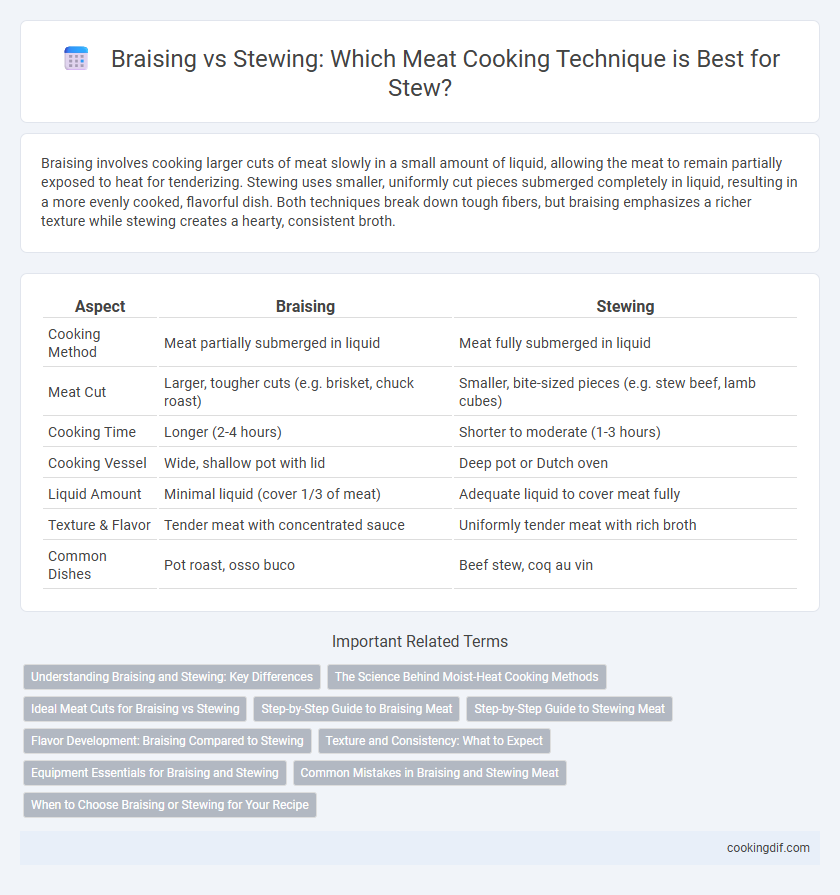Braising involves cooking larger cuts of meat slowly in a small amount of liquid, allowing the meat to remain partially exposed to heat for tenderizing. Stewing uses smaller, uniformly cut pieces submerged completely in liquid, resulting in a more evenly cooked, flavorful dish. Both techniques break down tough fibers, but braising emphasizes a richer texture while stewing creates a hearty, consistent broth.
Table of Comparison
| Aspect | Braising | Stewing |
|---|---|---|
| Cooking Method | Meat partially submerged in liquid | Meat fully submerged in liquid |
| Meat Cut | Larger, tougher cuts (e.g. brisket, chuck roast) | Smaller, bite-sized pieces (e.g. stew beef, lamb cubes) |
| Cooking Time | Longer (2-4 hours) | Shorter to moderate (1-3 hours) |
| Cooking Vessel | Wide, shallow pot with lid | Deep pot or Dutch oven |
| Liquid Amount | Minimal liquid (cover 1/3 of meat) | Adequate liquid to cover meat fully |
| Texture & Flavor | Tender meat with concentrated sauce | Uniformly tender meat with rich broth |
| Common Dishes | Pot roast, osso buco | Beef stew, coq au vin |
Understanding Braising and Stewing: Key Differences
Braising involves cooking larger cuts of meat partially submerged in liquid at low heat, allowing the tougher fibers to break down slowly while maintaining a firm texture. Stewing uses smaller, uniform pieces of meat fully immersed in liquid, resulting in a more tender and uniform consistency due to prolonged simmering. Both techniques optimize flavor development through slow cooking, but braising retains a more structured meat form compared to the soft, stew-like texture achieved by stewing.
The Science Behind Moist-Heat Cooking Methods
Braising and stewing both utilize moist-heat cooking methods that break down collagen in tougher cuts of meat into gelatin, enhancing tenderness and juiciness. Braising typically involves cooking larger pieces of meat partially submerged in liquid at low temperatures, promoting even heat penetration and flavor infusion. Stewing fully immerses smaller meat pieces in liquid, allowing for uniform collagen breakdown and a rich, concentrated broth through prolonged simmering.
Ideal Meat Cuts for Braising vs Stewing
Braising typically requires larger, tougher cuts of meat such as chuck roast, brisket, or short ribs, as the slow cooking process breaks down connective tissues and renders the meat tender while retaining moisture. Stewing is better suited for smaller, uniformly cut pieces like beef stew meat, lamb shoulder cubes, or pork shoulder, allowing the meat to cook evenly and absorb flavors throughout the liquid. Both techniques benefit from well-marbled, collagen-rich cuts that transform into succulent textures through low and slow heat.
Step-by-Step Guide to Braising Meat
Braising meat involves searing the meat at high heat until browned, then cooking it slowly in a covered pot with a small amount of liquid to break down tough fibers and enhance flavor. The liquid typically includes broth, wine, or a combination, which helps maintain moisture and tenderize the meat over low heat for several hours. This technique differs from stewing by using larger cuts of meat and less liquid, resulting in a rich sauce rather than a fully submerged cooking process.
Step-by-Step Guide to Stewing Meat
Stewing meat involves cutting it into uniform pieces, searing them in hot oil to develop a rich crust, then slowly simmering in a flavorful liquid with vegetables and herbs for several hours. Maintain low, consistent heat to break down connective tissues, resulting in tender, juicy meat that absorbs spices deeply. Regularly skim the surface to remove impurities and ensure clear broth while stirring occasionally to prevent sticking and promote even cooking.
Flavor Development: Braising Compared to Stewing
Braising involves cooking larger cuts of meat slowly in a small amount of liquid, allowing the meat to develop deeper, caramelized flavors through direct contact with heat and partial exposure to air. Stewing uses smaller meat pieces fully submerged in liquid, resulting in a more uniform, but milder flavor infusion throughout the dish. The Maillard reaction in braising enhances taste complexity, making it preferable for robust, richly flavored meals.
Texture and Consistency: What to Expect
Braising yields tender meat with a firm texture as it involves cooking larger cuts partially submerged in liquid at low heat, allowing connective tissues to break down slowly. Stewing cooks smaller, uniform pieces fully immersed in liquid, producing a softer, more uniform consistency with meat that easily falls apart. Expect braised dishes to have distinct meat pieces with a richer sauce, while stews offer a thicker, more homogenous texture throughout.
Equipment Essentials for Braising and Stewing
Braising requires a heavy, lidded pot such as a Dutch oven to maintain consistent heat and moisture, enabling slow cooking at low temperatures. Stewing equipment often involves a deep, heavy-bottomed pot designed for fully submerging smaller meat pieces, allowing for even cooking and flavor infusion. Both techniques benefit from cookware that offers excellent heat retention and tight seals to prevent moisture loss during the long cooking process.
Common Mistakes in Braising and Stewing Meat
Common mistakes in braising and stewing meat include using too much liquid, which can dilute flavors and result in a less tender texture. Overcrowding the pan prevents proper browning, leading to a lack of depth in taste and uneven cooking. Neglecting to maintain a low and steady temperature causes tough meat due to rapid moisture loss and insufficient collagen breakdown.
When to Choose Braising or Stewing for Your Recipe
Braising is ideal for larger, tougher cuts of meat like brisket or pork shoulder, as it uses less liquid and longer cooking times to tenderize while maintaining texture. Stewing suits smaller, uniform pieces such as beef cubes or lamb shoulder, fully immersed in liquid to ensure even cooking and rich flavor infusion. Choose braising for dishes requiring a thicker sauce and stewing for recipes needing a hearty, soupy consistency with tender, bite-sized meat pieces.
Braising vs Stewing for meat technique Infographic

 cookingdif.com
cookingdif.com